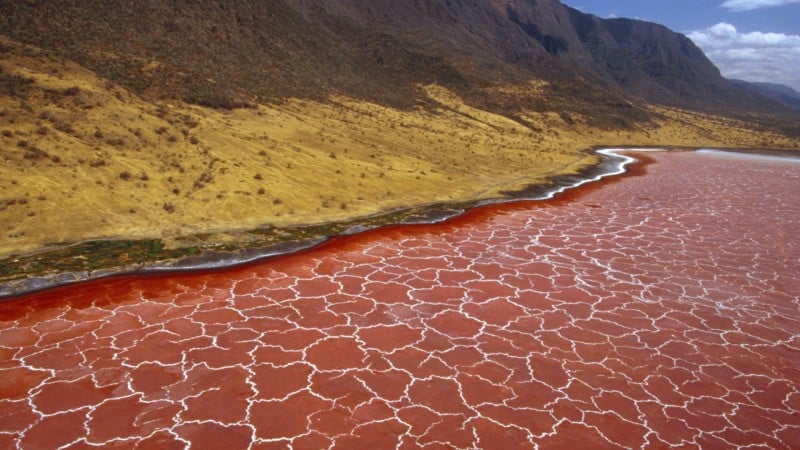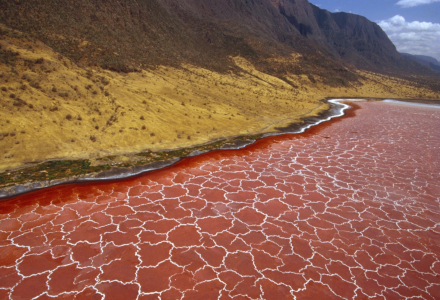
Lake Natron Facts:
- This stunning creation of natural forces bears the deceptively simple name of Lake Natron. But only the name qualifies as simple, though. That’s true since it ranks as a full marvel of Nature. It also boasts highly unusual physical properties.
- Its name belies its nature, though. The formation holds this title due to those same qualities. It’s named after a mineral known as natron. That’s an amalgamation of the chemicals forming hydrate sodium carbonate and sodium bicarbonate.
- This compound remains present in the body of water in prodigious quantities. The very distinctive chemical properties of the body of water have fascinating effects on the surroundings. At times, its contents are almost as caustic to the touch as ammonia!
- No record exists of how long the local Indigenous Peoples knew of its existence. It’s likely they long knew of its presence, however. This wonder of the earth remained completely unknown to the outside world, though, until its discovery in 1954.
- Today, the incredible attributes of Lake Natron justly earn it full appreciation. Despite the seeming inhospitableness of the site, it represents an important wetland within its region. That’s clearly acknowledged by its present listing as a Ramsar Site.
- This marvel of the world resides in a region full of other wonders. That’s because it formed on the continent of Africa. It sits in the East African Rift, like Ol Doinyo Lengai. More precisely, it lies within the current borders of the country of Tanzania.
Related Articles
Lake Natron Unique Flora
One might think that the extreme conditions within Lake Natron would render it devoid of life. Intriguingly, however, the reverse is actually the case. In its own way, this fabulous combination of conditions teems with life, albeit highly specialized types.
The microbiology of the body of unusual water remains dominated by salt-loving organisms. Given the high levels of this compound present, these thrive in vast quantities. Several species of these appear in the lake. The most prevalent one, though, is known as spirulina.
This cyanobacteria makes its own food, utilizing photosynthesis. One of the chemical compounds, an accessory to the process, is a bright red pigment. It’s this that creates the incredible eye-catching deep blood-red hues for which the site’s perhaps best known.
The extremely high evaporation rate of the waters of Lake Natron maintain this ecosystem. That’s because such a remarkable rate generates very high salinity levels. A thin, alkali salt crust forms on the surface, serving as the perfect environment to sustain the bacteria.
Lake Natron Wildlife
Despite the conditions of and immediately surrounding Lake Natron, bacteria aren’t the only life there. A surprising variety of fauna also calls the formation home. In the somewhat less salty, as well as slightly cooler regions around the edge, a few fish even survive.
Two species of these appear natively, in addition to one not endemic to the site. The native varieties consist of tilapias. They bear the unoriginal names of wide-lipped Natron tilapia, and the narrow-mouthed Natron tilapia. When the invasive one appeared is unknown.
A few hardy types of invertebrates also make their home here. Yet, the most visible inhabitant of the region is astonishing. That’s due to the fact that this site serves as the sole breeding ground for the 2.5 million lesser flamingoes. They depend on this one region.
They feed voraciously on the specialized bacteria present in Lake Natron. Indeed, it’s the red algae they consume that creates their trademark pink hue! Special evolutionary adaptations make it possible for them to survive and feed here. The conditions also limit predators.
Lake Natron Threats and Preservation Efforts
Lake Natron represents a truly geologically unique and vitally important habitat. Unfortunately, the few species adapted to its unique environment cannot survive elsewhere. That very adaptation, however, leaves them extremely vulnerable to a wide range of threats.
Sadly, projected logging activities currently threaten to disrupt the delicate salinity balance of the lake. A hydroelectric plant on the Ewaso River is under consideration. Both of these projects are poised to severely affect the delicate environmental balance of the lake.
A proposed soda ash plant at the site, suggested for one shore, also constitutes a threat. This plant would extract sodium carbonate from its waters. That’s one of the key components of the unique attributes of its water. The lesser flamingoes, however, could not feed on it.
Efforts to protect and preserve Lake Natron do exist, though. These efforts remain ongoing, yet need more support. Dozens of preservation societies and environmental organizations spearhead these efforts. Birdlife International represents one of the leading proponents.
Features Sharing Its Region
Check out our other articles on 3 Incredibly Intriguing Iguanas, European Honey Buzzard, Mount Kinabalu, Common Bottlenose Dolphin, Santa Rosa Island Manzanita

